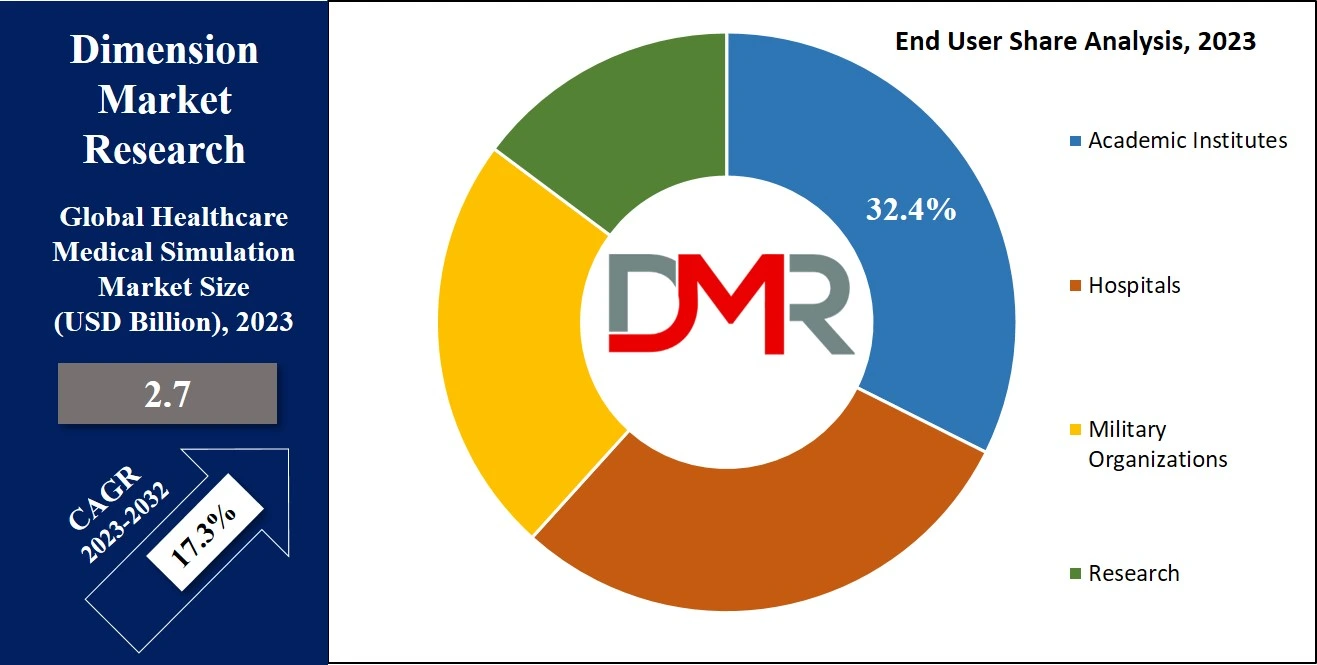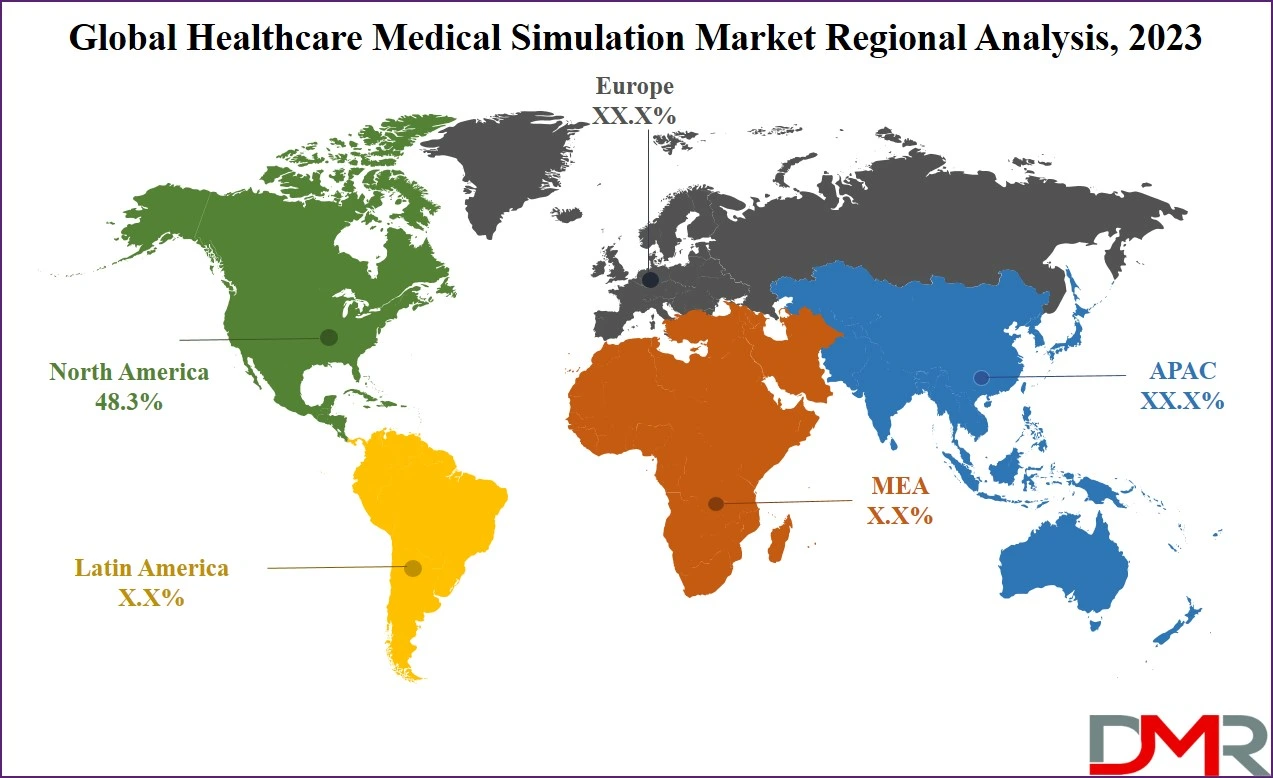The healthcare medical simulation market is influenced by several key trends that are shaping its future. The integration of
Artificial Intelligence (AI) into simulation software is becoming commonplace, allowing for adaptive learning environments tailored to the user's skill level. There is also a significant shift towards interprofessional education, utilizing simulation to foster better teamwork among healthcare providers.
Furthermore, the expansion of Virtual Reality (VR) and Augmented Reality (AR) technologies is enhancing the immersiveness of training experiences, which is anticipated to improve procedural skills and patient outcomes. Additionally, the advent of mobile technology has made simulation training more accessible, enabling healthcare professionals to engage in training flexibly and remotely.
The effectiveness of healthcare medical simulation is underscored by various research findings and industry reports. For instance, a survey focusing on Latin America identified a high concentration of simulation centers in countries like Chile, Brazil, and Mexico, indicating regional growth in simulation infrastructure.
Furthermore, a study cited by Tandfonline found that 92% of directors observed significant improvements in surgical outcomes with the use of 3D printed models over traditional imaging alone.
According to a report by the Training Industry, 72% of organizations employing simulation-based online training noted enhanced learner performance, with 68% reporting increased worker productivity. These figures not only validate the impact of medical simulation on healthcare training but also highlight its potential to boost productivity and enhance outcomes across healthcare settings.
By leveraging these trends and supporting data, companies can strategically position themselves in the market, offering innovative solutions that meet the evolving needs of healthcare professionals and contribute to superior patient care outcomes. The healthcare medical simulation market thus offers extensive opportunities for both established players and new entrants to innovate and thrive.
Key Takeaways
- The Global Healthcare Medical Simulation Market is forecasted to grow from USD 2.7 billion in 2023 to USD 11.4 billion by 2032, with a robust CAGR of 17.3%.
- Healthcare anatomical models dominate the market in 2023, crucial for trials in medical device development, with expected continued growth.
- Procedural rehearsal technology leads the market segments in 2023, fueled by the imperative to enhance patient safety amid rising medical errors.
- Academic institutions are the predominant end-users in 2023, leveraging computer models for complex biological research, indicating sustained growth in this sector.
- North America holds the largest market share at 48.3% in 2023, attributed to significant technological investments and the presence of major industry players.
Use cases
- Clinical Skills Training: Medical simulation offers a risk-free setting for healthcare professionals to practice procedures, enhancing both confidence and competence across a variety of clinical tasks.
- Interprofessional Education: Through simulated scenarios, different healthcare professionals can train together, improving teamwork and communication skills essential for effective patient care.
- Patient Safety and Quality Improvement: Simulation training prepares healthcare staff to effectively handle emergencies and rare incidents, thereby enhancing patient safety and care quality.
- Assessment and Certification: Simulations provide a standardized method to assess healthcare professionals’ competencies, essential for ensuring adherence to clinical standards in certifications and licensures.
- Research and Development: Medical simulation aids in the testing and development of new medical technologies and treatments, ensuring safety and efficacy before clinical application.
Healthcare Medical Simulation Market Dynamics
Medical simulators hold an essential role in global medical education, recreating human traits & addressing challenges like limited patient access & the imperative of ensuring patient safety during training. Further growing integrated into professional training & traditional learning, simulations allow students to refine clinical & critical thinking skills for high-risk situations.
In addition, integrating pre-education with simulation significantly improves student knowledge, performance confidence, nursing practice abilities, & satisfaction with learning techniques compared to pre-education or simulation alone.
Also, military organizations across the globe are adapting training models, highlighting simulation's potential to improve interdisciplinary medical team training. Government & non-government initiatives focused on enhancing healthcare worker training further contribute to market growth.
Healthcare Medical Simulation Market Research Scope and Analysis
By Product & Services
The market is segmented by products & services into web-based simulators, healthcare anatomical models, simulation training services, & healthcare simulation software. Within the healthcare anatomical model’s category, various subtypes like patient simulators, task trainers, dental simulators, interventional/surgical simulators, ultrasound simulators, endovascular simulators, & eye simulators.
As of 2023, the healthcare anatomical models segment holds the largest market share. These models prove essential in the research & manufacturing industry, facilitating trials & permutations before completing designs, processes, or systems, mainly in the
medical devices sector, which contribute to the segment's growth, with continued anticipation of expansion over the forecast period, showcasing the important role played by healthcare anatomical models in refining & advancing different aspects of medical research & development.
By Technology
The medical simulation market is categorized into virtual patient simulation, 3D printing, & procedural rehearsal technologies. As of 2023, the procedural rehearsal technology market holds the largest share, driven by the rising need for patient safety with the current increasing number of medical errors. Industry participants are constantly working on technological development, contributing to the expected expansion of this market.
Further, during the forecasted period, significant growth is anticipated in the virtual patient simulation market, which finds broad use in the academic programs of medical schools, showcasing a growing trend towards integrating virtual patient simulations for better medical education. The multifaceted applications of virtual patient simulation highlight its potential to play a major role in shaping the future of medical training & proficiency, aligning with the changing needs of medical education programs.
By End User
The market includes diverse end-user segments, like military organizations, academic institutions, research facilities, & hospitals, where in 2023, academic institutes represent the majority, driven by various research groups using computer models to explore complex biological systems, which is expected to persist, signaling ongoing growth in the academic research institutions sector.
Further, the hospital segment is anticipated to rapidly expand due to a gradual switch towards advanced learning methodologies. The introduction of cutting-edge simulation-based technologies & the comprehensive integration of simulation models in medical procedures contribute to this growth.
The emphasis on reducing errors, along with affordable procedural training for medical practitioners, positions the hospital segment to experience the fastest growth rate during the forecast period, reflecting an industry-wide commitment to innovative & effective medical training practices.

The Healthcare Medical Simulation Market Report is segmented based on the following:
By Product & Services
- Healthcare Anatomical Models
- Web-Based Simulators
- Healthcare Simulation Software
- Simulation Training Services
By Technology
- Procedure Rehearsal Technology
- Virtual Patient Simulation
- 3D Printing
By End User
- Academic Institutes
- Hospitals
- Military Organizations
- Research
Healthcare Medical Simulation Market Regional Analysis
North America leads the global healthcare medical simulation market with the largest revenue share at 48.3% in 2023, driven by the presence of key industry players & significant technological investments. The region's market growth is further driven by rapid technological advancements & the influence of a high disposable income. Further, these factors are expected to sustain & drive market expansion over the forecast period.

Moreover, in the Asia Pacific region, high growth is anticipated in the coming years, attributed to constant development in healthcare infrastructure. The region is also experiencing increased adoption of healthcare facilities, along with the quick expansion of manufacturing facilities in emerging economies like China & India, which is playing a major role in driving market growth in the Asia Pacific, indicating an encouraging outlook for the healthcare technology sector in the region.
By Region
North America
Europe
- Germany
- The U.K.
- France
- Italy
- Russia
- Spain
- Benelux
- Nordic
- Rest of Europe
Asia-Pacific
- China
- Japan
- South Korea
- India
- ANZ
- ASEAN
- Rest of Asia-Pacific
Latin America
- Brazil
- Mexico
- Argentina
- Colombia
- Rest of Latin America
Middle East & Africa
- Saudi Arabia
- UAE
- South Africa
- Israel
- Egypt
- Rest of MEA
Healthcare Medical Simulation Market Competitive Landscape
The healthcare medical simulation market is characterized by various players, mostly small & medium-sized, leading to intense competition. In recent years, the sector has seen an inrush of new entrants, driven by the growing appeal of simulation technology. Further, existing players are distinguishing themselves through factors like pricing, quality, & technological developments as they navigate this dynamic landscape.
In January 2022, Inovus Medical introduced HystAR, an advanced hysteroscopy simulator, which merges augmented reality technology & a cloud-based learning platform with the authentic tactile experience of simulated tissue models. The result is a highly realistic & scalable training tool for hysteroscopy skills. By combining these elements, Inovus Medical focuses on providing a comprehensive & advanced simulation solution for effective & captivating medical training in this specific procedure.
Some of the prominent players in the global Healthcare Medical Simulation Market are:
- 3D Systems
- Mentice AB
- CAE
- Simulaids
- Limbs & Things Ltd
- Cardionics Inc
- Laderdal Medical
- Kyoto Kagaku Co Ltd
- Inovus Medical
- Gaumard Scientific
- Other Key Players
Recent Development
- In January 2024, Oxford Medical Simulation secured $12.6 million in Series A funding to enhance their VR training platforms for healthcare professionals, aiming to expand their reach and develop more advanced simulation scenarios.
- In March 2023, healthcare simulation startup SimConverse successfully raised $1.5 million in seed funding to innovate and expand its conversational AI capabilities, designed to improve diagnostic skills through simulated patient interactions.
- In June 2023, a significant grant of $1.2 million was awarded to support projects focusing on healthcare analytics and artificial intelligence, with the aim of advancing the research and implementation of AI-driven tools in medical care settings.
Report Details
| Report Characteristics |
| Market Size (2023) |
USD 2.7 Bn |
| Forecast Value (2032) |
USD 11.4 Bn |
| CAGR (2023-2032) |
17.3% |
| Historical Data |
2017 - 2022 |
| Forecast Data |
2023 - 2032 |
| Base Year |
2022 |
| Estimate Year |
2023 |
| Report Coverage |
Market Revenue Estimation, Market Dynamics, Competitive Landscape, Growth Factors and etc. |
| Segments Covered |
By Product & Services (Healthcare Anatomical Models, Web-Based Simulators, Healthcare Simulation Software, and Simulation Training Services), By Technology (Procedure Rehearsal Technology, Virtual Patient Simulation, 3D Printing), By End User (Academic Institutes, Hospitals, Military Organizations, and Research) |
| Regional Coverage |
North America – The US and Canada; Europe – Germany, The UK, France, Russia, Spain, Italy, Benelux, Nordic, & Rest of Europe; Asia- Pacific– China, Japan, South Korea, India, ANZ, ASEAN, Rest of APAC; Latin America – Brazil, Mexico, Argentina, Colombia, Rest of Latin America; Middle East & Africa – Saudi Arabia, UAE, South Africa, Turkey, Egypt, Israel, & Rest of MEA |
| Prominent Players |
3D Systems, Mentice AB, CAE, Simulaids, Limbs & Things Ltd, Cardionics Inc, Laderdal Medical, Kyoto Kagaku Co Ltd, Inovus Medical, Gaumard Scientific, and Other Key Players |
| Purchase Options |
We have three licenses to opt for: Single User License (Limited to 1 user), Multi-User License (Up to 5 Users), and Corporate Use License (Unlimited User) along with free report customization equivalent to 0 analyst working days, 3 analysts working days and 5 analysts working days respectively. |